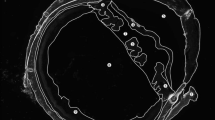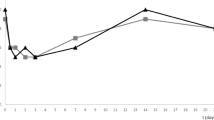Abstract
The primary objective of this study was to investigate the feasibility of using PEO-PPO-PEO non-ionic copolymeric micelles as a carrier for eye-drop gene delivery of plasmid DNA with lacZ gene in vivo. Using pyrene fluorescence probe methods, zeta potential, and dynamic light scattering test (DLS), the ability of micelle formation of these block copolymers with plasmid was studied. Gene expressions were visualized by both the quality of enzymatic color reaction using X-gal staining and by the quantification of the substrate chlorophenol red galactopyranoside (CPRG) in enucleated eyes on day 2 after gene transfer. In addition, microscopy to identify the types of cell showing uptake and expression of the transferred gene was used. We found that the block polymeric micelles were formed above 0.1% (w/v) of block copolymer with a size of 160 nm and a zeta potential of −4.4 mV. After 2 days of topically delivery three times a day, the most intense gene expression was observed on days 2 and 3. Reporter expression was detected around the iris, sclera, conjunctiva, and lateral rectus muscle of rabbit eyes and also in the intraocular tissues of nude mice upon in vivo topical application for 48 h with a DNA/polymeric micelle formulation. Furthermore, after two enhancement treatments, the transport mechanisms of the block copolymeric micelles were found through endocytosis in tissues by enhancement through the tight junction pathway. Thus, efficient and stable transfer of the functional gene could be achieved with PEO-PPO-PEO polymeric micelles through topical delivery in mice and rabbits. These in vivo experiments indicate the possible potential use of block copolymers for DNA transfer.
This is a preview of subscription content, access via your institution
Access options
Subscribe to this journal
Receive 12 print issues and online access
$259.00 per year
only $21.58 per issue
Buy this article
- Purchase on Springer Link
- Instant access to full article PDF
Prices may be subject to local taxes which are calculated during checkout


Similar content being viewed by others
References
Ledley FD . Nonviral gene therapy: the promise of genes as pharmaceutical products Hum Gene Ther 1995 6: 1129–1144
1Yi SW, Yune TY, Kim TW, Chung H . A cationic lipid emulsion/DNA complex as a physically stable and serum resistant gene delivery system Pharm Res 2000 17: 314–320
Huang L, Hung MC, Wagner E . Nonviral Vector for Gene Therapy Academic Press: San Diego 1999 pp 1–35
Godbey WT, Wu KK, Mikos AG . Poly(ethylenimine) and its role in gene delivery J Control Rel 1999 60: 149–160
Escriou V, Ciolina C, Lacroix F, Byk G . Cationic lipid-mediated gene transfer: effect of serum on cellular uptake and intracellular fate of lipopolyamine/DNA complexes Biochim Biophys Acta 1998 1368: 276–288
Schmolka IR . Poloxamers in the pharmaceutical industry. In Tarcha PJ (ed.) Polymers for Controlled Drug Delivery CRC Press: Boca Raton, FL 1991 pp 189–214
Yalin M, Oner F, Oner L, Hincal AA . Preparation and properties of a stable intravenous lorazepam emulsion J Clin Pharm Ther 1997 22: 39–44
Yoon J K, Burgess DJ . Interfacial properties as stability predictors of lecithin-stabilized perfluorocarbon emulsions Pharm Dev Technol 1996 1: 333–341
Liaw J, Aoyagi T, Kataoka K, Sakurai Y . Permeation of PEO-PBLA-FITC polymeric micelles in aortic endothelial cells Pharm Res 1999 16: 213–220
Kwon GK, Naito M, Yokoyama M, Okano T . Physical entrapment of adriamycin in AB block copolymer micelles Pharm Res 1995 12: 192–195
Liaw J, Lin YC . Evaluation of poly(ethylene oxide)-poly (propylene oxide)-poly(ethylene oxide) (PEO-PPO-PEO) gels as a release vehicle for percutaneous fentanyl J Control Rel 2000 68: 273–282
Cherng JY, Schuurmanns-Nieuwenbroek NME, Jiskoot W, Talsma H . Effect of DNA topology on the transfection efficiency of poly(2-dimethylamino)ethyl methacrylate)–plasmid complexes J Control Rel 1999 60: 343–353
Tang M, Szoka FC . The influence of polymer structure on the interactions of cationic polymers with DNA and morphology of the resulting complexes Gene Therapy 1997 4: 823–832
Liaw J, Robinson JR . The effect of polyethylene glycol molecular weight on corneal transport and the related influence of penetration enhancers Intern J Pharm 1992 88: 125–140
Vinogradov SV, Bronich TK, Kabanov AV . Self-assembly of polyamin-poly(ethylene glycol) copolymers with phosphorothioate oligonucleotides Bioconjug Chem 1998 9: 805–812
Shiraishi A, Converse RL, Liu CY, Zhou F, Kao CWC, Kao WW . Identification of the cornea specific keratin 12 promoter by in vivo particle-mediated gene transfer Invest Ophthalmol Vis Sci 1998 39: 2554–2561
Alakhov VY, Moskaleva EY, Batrkova EV, Kabanov AV . Hypersensitization of multidrug resistant human ovarian carcinoma cells by Pluronic P85 block copolymer Bioconjug Chem 1995 7: 209–216
Masuda I, Matsuo T, Yasuda T, Matsuo N . Gene transfers with liposomes to the intraocular tissues by different routes of administration Invest Ophthal Vis Sci 1996 37: 1914–1920
Madara LJ, Barenberg D, Carlson S . Effect of cytochalasin D on occluding junction of intestinal absorptive cells: further evidence that the cytoskeleton may influence paracellular permeability and junctional charge selectively J Cell Biol 1986 102: 2125–2136
Lam AMI, Cullis PR . Calcium enhances the transfection potency of plasmid DNA–cationic liposome complexes Biochim Biophys Acta 2000 1463: 279–290
MacGregor GR, Caskey CT . Construction of plasmids that express E. coli β-galactosidase in mammalian cells Nucleic Acids Res 1989 17: 2365–2369
Oshima Y, Sakamoto T, Yamanaka I, Nishi T . Targeted gene transfer to corneal endothelium in vivo by electric pulse Gene Therapy 1998 5: 1347–1354
Acknowledgements
This work was supported by grants from the National Science Council (NSC89-2314–B038-004) and Taipei Medical University (TMC89-Y05-A133).
Author information
Authors and Affiliations
Rights and permissions
About this article
Cite this article
Liaw, J., Chang, SF. & Hsiao, FC. In vivo gene delivery into ocular tissues by eye drops of poly(ethylene oxide)-poly(propylene oxide)-poly(ethylene oxide) (PEO-PPO-PEO) polymeric micelles. Gene Ther 8, 999–1004 (2001). https://doi.org/10.1038/sj.gt.3301485
Received:
Accepted:
Published:
Issue Date:
DOI: https://doi.org/10.1038/sj.gt.3301485
Keywords
This article is cited by
-
Bioadhesive hyaluronan–chitosan nanoparticles can transport genes across the ocular mucosa and transfect ocular tissue
Gene Therapy (2008)
-
Amphiphilic triblock copolymer poly(p-dioxanone-co-L-lactide)-block-poly(ethylene glycol), enhancement of gene expression and inhibition of lung metastasis by aerosol delivery
Gene Therapy (2007)
-
Micellar Nanocarriers: Pharmaceutical Perspectives
Pharmaceutical Research (2006)



